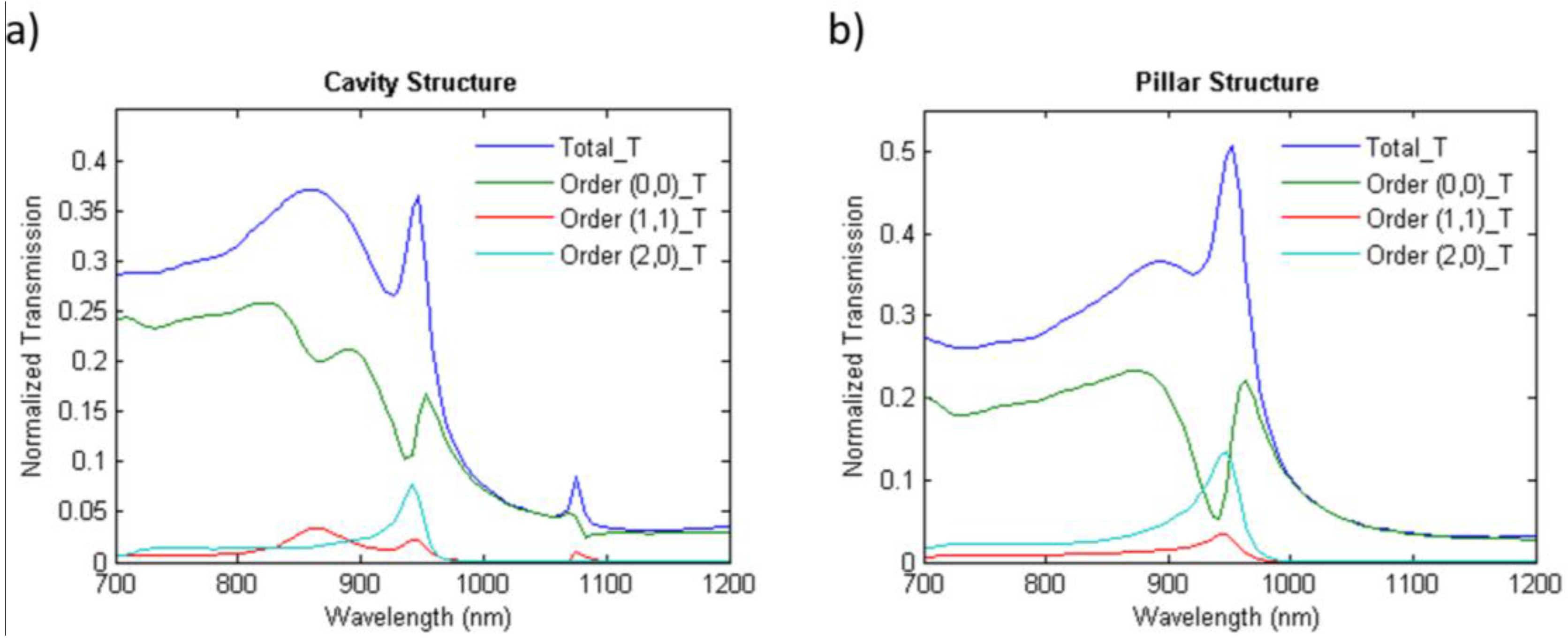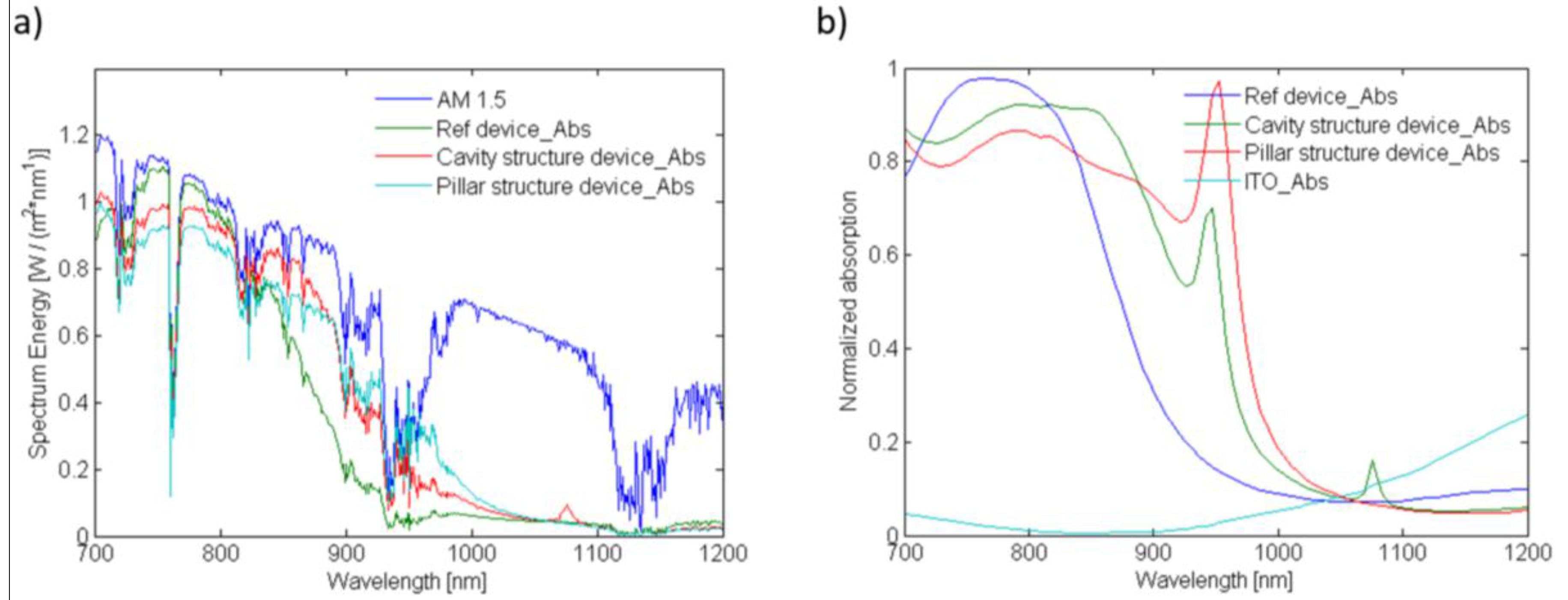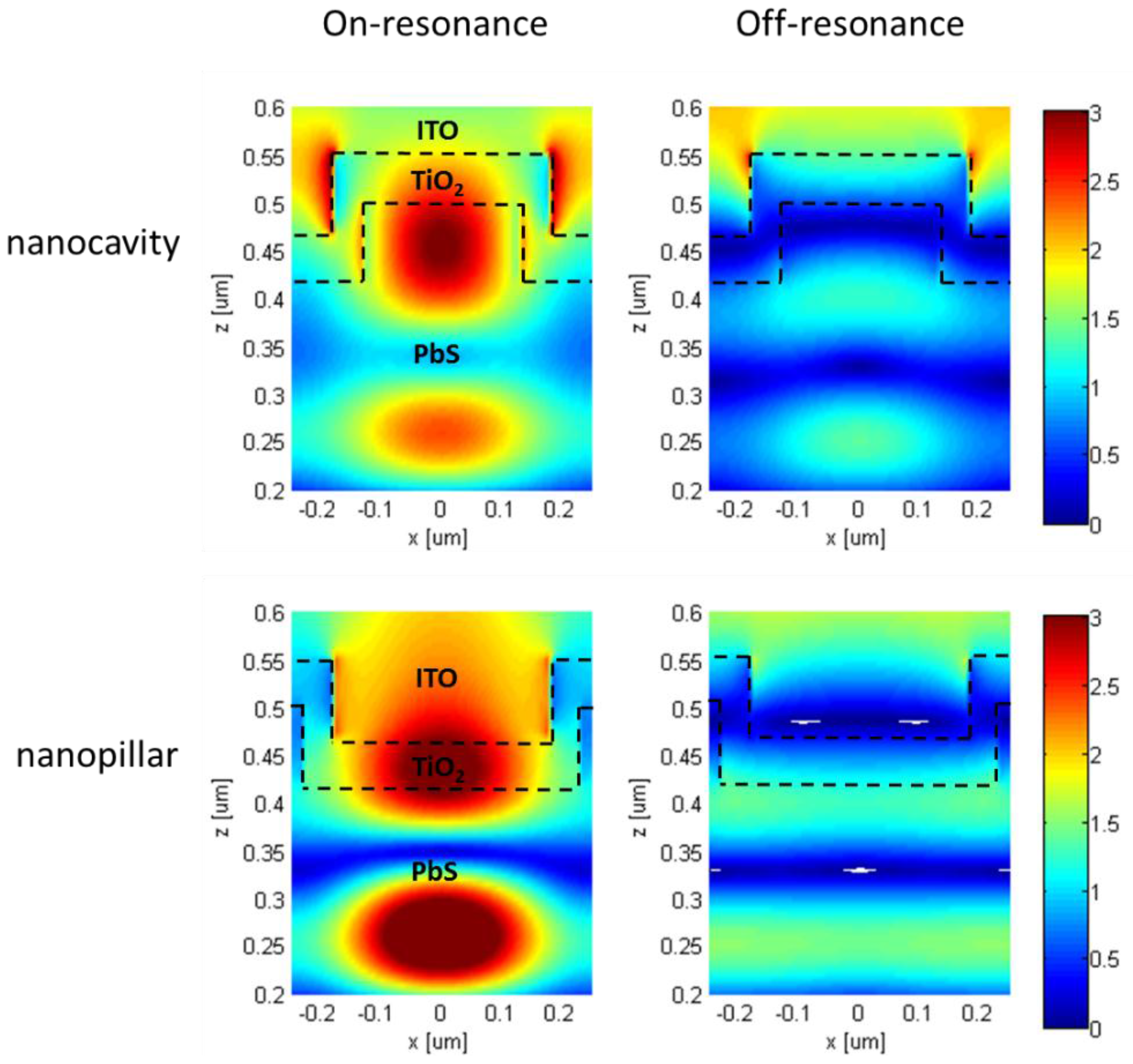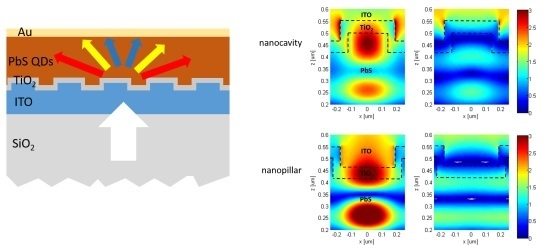Numerical Study of Complementary Nanostructures for Light Trapping in Colloidal Quantum Dot Solar Cells
Abstract
:1. Introduction
2. Results and Discussion
2.1. Structure Design
2.2. Light Trapping Analysis
3. Materials and Methods
3.1. Complementary Structure Fabrication
3.2. Simulation Methods
4. Conclusions
Abbreviations
| CQD | Colloidal Quantum Dot |
| ITO | Indium-doped Tin Oxide |
| NSL | Nano Sphere Lithography |
| RIE | Reactive Ion Etching |
| SEM | Scanning Electron Microscope |
| PDMS | Polydimethylsiloxane |
| FDTD | Finite Difference Time Domain |
Acknowledgments
Author Contributions
Conflicts of Interest
References
- Chang, L.Y.; Lunt, R.R.; Brown, P.R.; Bulovic, V.; Bawendi, M.G. Low-temperature solution-processed solar cells based on PbS colloidal quantum dot/CdS heterojunctions. Nano Lett. 2013, 13, 994–999. [Google Scholar] [CrossRef] [PubMed]
- Tang, J.; Sargent, E.H. Infrared colloidal quantum dots for photovoltaics: Fundamentals and recent progress. Adv. Mater. 2011, 23, 12–29. [Google Scholar] [CrossRef] [PubMed]
- Clifford, J.P.; Konstantatos, G.; Johnston, K.W.; Hoogland, S.; Levina, L.; Sargent, E.H. Fast, sensitive and spectrally tuneablecolloidal-quantum-dot photodetectors. Nat. Nanotechnol. 2009, 4, 40–44. [Google Scholar] [CrossRef] [PubMed]
- Zhitomirsky, D.; Voznyy, O.; Hoogland, S.; Sargent, E.H. Measuring charge carrier diffusion in coupled colloidal quantum dot solids. ACS Nano 2013, 7, 5282–5290. [Google Scholar] [CrossRef] [PubMed]
- Labelle, A.J.; Thon, S.M.; Kim, J.Y.; Lan, X.; Zhitomirsky, D.; Kemp, K.W.; Sargent, E.H. Conformal fabrication of colloidal quantum dot solids for optically enhanced photovoltaics. ACS Nano 2015, 9, 5447–5453. [Google Scholar] [CrossRef] [PubMed]
- Brongersma, M.L.; Cui, Y.; Fan, S. Light management for photovoltaics using high-index nanostructures. Nat. Mater. 2014, 13, 451–460. [Google Scholar] [CrossRef] [PubMed]
- Cao, S.; Yu, W.; Wang, T.; Xu, Z.; Wang, C.; Fu, Y.; Liu, Y. Two-dimensional subwavelength meta-nanopillar array for efficient visible light absorption. Appl. Phys. Lett. 2013, 102, 161109. [Google Scholar] [CrossRef]
- Han, Q.; Jin, L.; Fu, Y.Q.; Yu, W.X. Si substrate-based metamaterials for ultrabroadbandperfect absorption in visible regime. J. Nanomater. 2014, 2014, 893202. [Google Scholar]
- Han, S.E.; Chen, G. Optical absorption enhancement in silicon nanoholearrays for solar photovoltaics. Nano Lett. 2010, 10, 1012–1015. [Google Scholar] [CrossRef] [PubMed]
- Lin, C.; Povinelli, M.L. Optical absorption enhancement in silicon nanowire arrays with a large lattice constant for photovoltaic applications. Opt. Express 2009, 17, 19371–19381. [Google Scholar] [CrossRef] [PubMed]
- Adachi, M.M.; Labelle, A.J.; Thon, S.M.; Lan, X.; Hoogland, S.; Sargent, E.H. Broadband solar absorption enhancement via periodic nanostructuring of electrodes. Sci. Rep. 2013, 3. [Google Scholar] [CrossRef] [PubMed]
- Fu, Y.; Dinku, A.G.; Hara, Y.; Miller, C.W.; Vrouwenvelder, K.T.; Lopez, R. Modeling photovoltaic performance in periodic patterned colloidal quantum dot solar cells. Opt. Express 2015, 23, A779–A790. [Google Scholar] [CrossRef] [PubMed]
- Kim, J.; Koh, J.K.; Kim, B.; Kim, J.H.; Kim, E. Nanopatterning of mesoporous inorganic oxide films for efficient light harvesting of dye-sensitized solar cells. Angew. Chem. Int. Ed. 2012, 51, 6864–6869. [Google Scholar] [CrossRef] [PubMed]
- Na, J.; Kim, Y.; Park, C.; Kim, E. Multi-layering of a nanopatterned TiO2 layer for highly efficient solid-state solar cells. NPG Asia Mater. 2015, 7, E217. [Google Scholar] [CrossRef]
- Atwater, H.A.; Polman, A. Plasmonics for improved photovoltaic devices. Nat. Mater. 2010, 9, 205–213. [Google Scholar] [CrossRef] [PubMed]
- Ding, I.-K.; Zhu, J.; Cai, W.; Moon, S.-J.; Cai, N.; Wang, P.; Zakeeruddin, S.M.; Grätzel, M.; Brongersma, M.L.; Cui, Y.; et al. Plasmonic dye-sensitized solar cells. Adv. Energy Mater. 2011, 1, 52–57. [Google Scholar] [CrossRef]
- Min, C.; Li, J.; Veronis, G.; Lee, J.-Y.; Fan, S.; Peumans, P. Enhancement of optical absorption in thin-film organic solar cells through the excitation of plasmonic modes in metallic gratings. Appl. Phys. Lett. 2010, 96, 133302. [Google Scholar] [CrossRef]
- Raman, A.; Yu, Z.; Fan, S. Dielectric nanostructures for broadband light trapping in organic solar cells. Opt. Express 2011, 19, 19015–19026. [Google Scholar] [CrossRef] [PubMed]
- Mahpeykar, S.M.; Xiong, Q.; Wang, X. Resonance-induced absorption enhancement in colloidal quantum dot solar cells using nanostructured electrodes. Opt. Express 2014, 22, 1576–1588. [Google Scholar] [CrossRef] [PubMed]
- Hall, A.S.; Friesen, S.A.; Mallouk, T.E. Wafer-scale fabrication of plasmoniccrystals from patterned silicon templates prepared by nanospherelithography. Nano Lett. 2013, 13, 2623–2627. [Google Scholar] [CrossRef] [PubMed]
- Yang, S.; Lapsley, M.I.; Cao, B.; Zhao, C.; Zhao, Y.; Hao, Q.; Kiraly, B.; Scott, J.; Li, W.; Wang, L.; et al. Large-scale fabrication of three-dimensional surface patterns using template-defined electrochemical deposition. Adv. Funct. Mater. 2013, 23, 720–730. [Google Scholar] [CrossRef]
- Lumerical Solutions Inc. Grating Projections. Available online: http://docs.lumerical.com/en/solvers_grating_projections.html (accessed on 15 February 2016).
- Yu, J.; Geng, C.; Zheng, L.; Ma, Z.; Tan, T.; Wang, X.; Yan, Q.; Shen, D. Preparation of high-quality colloidal mask for nanospherelithography by a combination of air/water interface self-assembly and solvent vapor annealing. Langmuir 2012, 28, 12681–12689. [Google Scholar] [CrossRef] [PubMed]
- Synowicki, R.A. Spectroscopic ellipsometry characterization of indium tin oxide film microstructure and optical constants. Thin Solid Films 1998, 313–314, 394–397. [Google Scholar] [CrossRef]
- Palik, E.D. Handbook of Optical Constants of Solids; Academic Press: Cambridge, MA, USA, 1998; pp. 12–24. [Google Scholar]
- SOPRA Refractive Index Database. Available online: http://www.soprasteria.com (accessed on 15 February 2016).
- Wang, X.; Koleilat, G.I.; Tang, J.; Liu, H.; Kramer, I.J.; Debnath, R.; Brzozowski, L.; Barkhouse, D.A.R.; Levina, L.; Hoogland, S.; et al. Tandem colloidal quantum dot solar cells employing a graded recombination layer. Nat. Photon. 2011, 5, 480–484. [Google Scholar] [CrossRef]
- Reference Solar Spectral Irradiance: ASTM G-173. Available online: http://rredc.nrel.gov/solar/spectra/am1.5/ASTMG173/ASTMG173.html (accessed on 15 February 2016).





© 2016 by the authors; licensee MDPI, Basel, Switzerland. This article is an open access article distributed under the terms and conditions of the Creative Commons by Attribution (CC-BY) license (http://creativecommons.org/licenses/by/4.0/).
Share and Cite
Wei, J.; Xiong, Q.; Mahpeykar, S.M.; Wang, X. Numerical Study of Complementary Nanostructures for Light Trapping in Colloidal Quantum Dot Solar Cells. Nanomaterials 2016, 6, 55. https://doi.org/10.3390/nano6040055
Wei J, Xiong Q, Mahpeykar SM, Wang X. Numerical Study of Complementary Nanostructures for Light Trapping in Colloidal Quantum Dot Solar Cells. Nanomaterials. 2016; 6(4):55. https://doi.org/10.3390/nano6040055
Chicago/Turabian StyleWei, Jue, Qiuyang Xiong, Seyed Milad Mahpeykar, and Xihua Wang. 2016. "Numerical Study of Complementary Nanostructures for Light Trapping in Colloidal Quantum Dot Solar Cells" Nanomaterials 6, no. 4: 55. https://doi.org/10.3390/nano6040055






